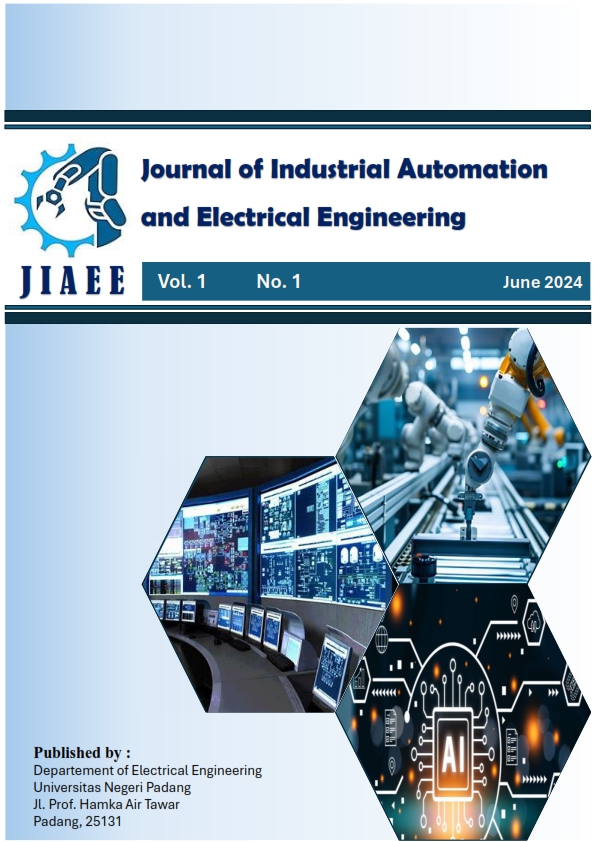Photovoltaic system performance improvement by applying enhanced incremental conductance algorithm
Keywords:
Incremental Conductance, Photovoltaic , Maximum power, ArduinoAbstract
This research aims to optimize the performance of a photovoltaic system using the Incremental Conductance algorithm (INC). The incremental conductance method is susceptible to oscillations in the steady state and tracking accuracy under solar radiation variations. This research investigates how Incremental conductance can be modified to improve its performance in reducing oscillations and accelerating cycle speed. Tests were carried out at irradiation variations of 200, 400 and 600 W/m². The INC method produces conventional tracking times of 500 ms, 555 ms, and 300 ms with maximum power of 1.89 W, 5,542 W, and 8,232 W at increased irradiation. Meanwhile the INC modification method shows a significant improvement with tracking times of 345 ms, 330 ms, and 205 ms, producing maximum power of 2.73 W, 7.36 W, and 9.9 W. When reducing irradiation, the modification method achieves tracking times of 195 ms and 455 ms. These results show that the INC modification method is superior in reducing oscillations, speeding up tracking time, and producing higher maximum power so as to increase the overall efficiency of the photovoltaic system
Downloads
References
[1] R. K. Jain, H. K. V. Gadiraju, V. R. Barry and S. R. Parne, "High Performance MPPT Controller based on Adaptive Sliding Mode Control," 2020 21st National Power Systems Conference (NPSC), Gandhinagar, India, 2020, pp. 1-6, doi: 10.1109/NPSC49263.2020.9331826
[2] J. Mishra, S. Das, D. Kumar and M. Pattnaik, "Performance Comparison of P&O and INC MPPT Algorithm for a Stand-alone PV System," 2019 Innovations in Power and Advanced Computing Technologies (i-PACT), Vellore, India, 2019, pp. 1-5, doi: 10.1109/i-PACT44901.2019.8960005.
[3] S. Sadhukhan et al., "Improvement in the Performance of P-Type Tunnel Oxide Passivated Contact Solar Cell With Selective Tunneling Junctions Underneath the Contacts on Front Side," IEEE Journal of Photovoltaics, vol. 13, no. 2, pp. 236-241, March 2023, doi: 10.1109/JPHOTOV.2023.3238270.
[4] M. Yuhendri and G. S. Putra, “Implementasi Sistem Kendali MPPT Panel Surya Berbasis Algoritma Incremental Conductance,” JTEIN: Jurnal Teknik Elektro Indonesia, vol. 1, no. 2, pp. 218–223, 2020, doi: 10.24036/jtein.v1i2.72.
[5] M. E. Başoğlu, “Comprehensive review on distributed maximum power point tracking: Submodule level and module level MPPT strategies,” Solar Energy, vol. 241, no. June, pp. 85–108, 2022, doi: 10.1016/j.solener.2022.05.039.
[6] A. Majeed Shaikh, M. Fawad Shaikh, S. Ahmed Shaikh, M. Krichen, R. Ali Rahimoon, and A. Qadir, “Comparative analysis of different MPPT techniques using boost converter for photovoltaic systems under dynamic shading conditions,” Sustain. Energy Technol. Assessments, vol. 57, no. May, p. 103259, 2023, doi: 10.1016/j.seta.2023.103259
[7] H. Masrepol and M. Yuhendri, “Implementasi MPPT Panel Surya Berbasis Algoritma Perturbasi & Observasi (PO) Menggunakan Arduino,” JTEIN: Jurnal Teknik Elektro Indonesia, vol. 2, no. 2, pp. 162–167, 2021, doi: 10.24036/jtein.v2i2.155.
[8] M. Mao, L. Cui, Q. Zhang, K. Guo, L. Zhou, and H. Huang, “Classification and summarization of solar photovoltaic MPPT techniques: A review based on traditional and intelligent control strategies,” Energy Reports, vol. 6, no. 174, pp. 1312–1327, 2020, doi: 10.1016/j.egyr.2020.05.013.
[9] M. A. Husain, Z. A. Khan, and A. Tariq, “A novel solar PV MPPT scheme utilizing the difference between panel and atmospheric temperature,” Renew. Energy Focus , vol. 19–20, no. 00, pp. 11–22, 2017, doi: 10.1016/j.ref.2017.03.009.
[10] A. Lindo and M. Yuhendri, “Sistem Kendali Daya Maksimum Panel Surya Berbasis Fuzzy Logic Controller,” JTEIN J. Tek. Elektro Indones., vol. 3, no. 1, pp. 102–110, 2022, doi: 10.24036/jtein.v3i1.207.
[11] N. Karami, N. Moubayed, and R. Outbib, “General review and classification of different MPPT Techniques,” Renew. Sustain. Energy Rev., vol. 68, no. September 2016, pp. 1–18, 2017, doi: 10.1016/j.rser.2016.09.132.
[12] B. Subudhi and R. Pradhan, "A Comparative Study on Maximum Power Point Tracking Techniques for Photovoltaic Power Systems," in IEEE Transactions on Sustainable Energy, vol. 4, no. 1, pp. 89-98, Jan. 2013, doi: 10.1109/TSTE.2012.2202294.
[13] D. Lakshmi and M. R. Rashmi, "A modified incremental conductance algorithm for partially shaded PV array," 2017 International Conference on Technological Advancements in Power and Energy ( TAP Energy), Kollam, India, 2017, pp. 1-6, doi: 10.1109/TAPENERGY.2017.8397209.
[14] N. Barkat and A. Iqbal Bhatti, "A Comparative Study of Different Modified Incremental Conductance MPPT Algorithms Under very Fast-Changing Atmospheric Conditions for Solar Charging Station," 2021 16th International Conference on Emerging Technologies (ICET), Islamabad, Pakistan, 2021, pp. 1-6, doi: 10.1109/ICET54505.2021.9689795.
[15] S. Sadhukhan et al., "Improvement in the Performance of P-Type Tunnel Oxide Passivated Contact Solar Cell With Selective Tunneling Junctions Underneath the Contacts on Front Side," IEEE Journal of Photovoltaics, vol. 13, no. 2, pp. 236-241, March 2023, doi: 10.1109/JPHOTOV.2023.3238270.
[16] R. Zaitsev et al., "Dependence of the Thin Film Solar Cells Efficiency from Operating Temperature," 2019 IEEE 2nd Ukraine Conference on Electrical and Computer Engineering (UKRCON), Lviv, Ukraine, 2019, pp. 1-6, doi: 10.1109/UKRCON.2019.8879823.
[17] Asnil, Krismadinata, I. Husnaini, and E. Astrid, “Characteristics of photovoltaic modules in various configurations for partial shading conditions,” J. Theor. Appl. Inf. Technol., vol. 99, no. 22, pp. 5287–5299, 2021.
[18] Z. Zhen, X. Taoyun, S. Yanping, L. Wang, P. Jia and J. Yu, "A Method to Test Operating Cell Temperature for BIPV Modules," IEEE Journal of Photovoltaics, vol. 6, no. 1, pp. 272-277, Jan. 2016, doi: 10.1109/JPHOTOV.2015.2501719
[19] Krismadinata, F. B. Aulia, and R. Maulana, “Development of graphical user interface for boost converter employing visual studio Development of graphical user interface for boost converter employing visual studio,” in IOP Conf. Ser.: Earth Environ. Sci, 2023. doi: 10.1088/1755-1315/1281/1/012037
[20] M. Kumar, G. Panda and D. V. S. K. R. K, "Analysis of Conventional and Interleaved Boost Converter with Solar Photovoltaic System," 2022 International Conference on Intelligent Controller and Computing for Smart Power (ICICCSP), Hyderabad, India, 2022, pp. 1-6, doi: 10.1109/ICICCSP53532.2022.9862351.
[21] A. Belkaid, I. Colak, and O. Isik, “Photovoltaic maximum power point tracking under fast varying of solar radiation,” Applied Energy, vol. 179, pp. 523–530, 2016, doi: 10.1016/j.apenergy.2016.07.034.
[22] S. S. Menon, R. R. Prasad and R. R. Singh, "Performance Analysis of MPPT Integrated Solar Charger for Electric Vehicle Battery," 2021 Innovations in Power and Advanced Computing Technologies (i-PACT), Kuala Lumpur, Malaysia, 2021, pp. 1-6, doi: 10.1109/i-PACT52855.2021.9696742.
[23] A. Asnil, K. Krimadinata, E. Astrid, and I. Husnaini, “Enhanced Incremental Conductance Maximum Power Point Tracking Algorithm for Photovoltaic System in Variable Conditions,” J. Eur. des Syst. Autom., vol. 57, no. 1, pp. 33–43, 2024, doi: 10.18280/jesa.570104.
[24] S. A. Dinakaran, A. Bhuvanesh, A. S. Kamaraja, P. Anitha, K. K. Kumar, and P. N. Kumar, “Measurement : Sensors Modelling and performance analysis of improved incremental conductance MPPT technique for water pumping system,” Meas. Sensors, vol. 30, no. April, p. 100895, 2023, doi: 10.1016/j.measen.2023.100895.
[25] I. F. Sanul and M. Yuhendri, “Sistem Kendali MPPT Panel Surya Dengan Menggunakan Algoritma Jaringan Saraf Tiruan,” JTEIN J. Tek. Elektro Indones., vol. 4, no. 1, pp. 345–352, 2023
[26] R. Ika, S. Wibowo, and M. Rifa, “Maximum power point tracking for photovoltaic using incremental conductance method,” Energy Procedia, vol. 68, pp. 22–30, 2015, doi: 10.1016/j.egypro.2015.03.228.
[27] E. Akin and M. E. Şahın, "Investigation of Incremental Conductance MPPT Algorithm in MATLAB/Simulink Using Photovoltaic Powered DC-DC Boost Converter," 2023 22nd International Symposium on Power Electronics (Ee), Novi Sad, Serbia, 2023, pp. 1-6, doi: 10.1109/Ee59906.2023.10346089







